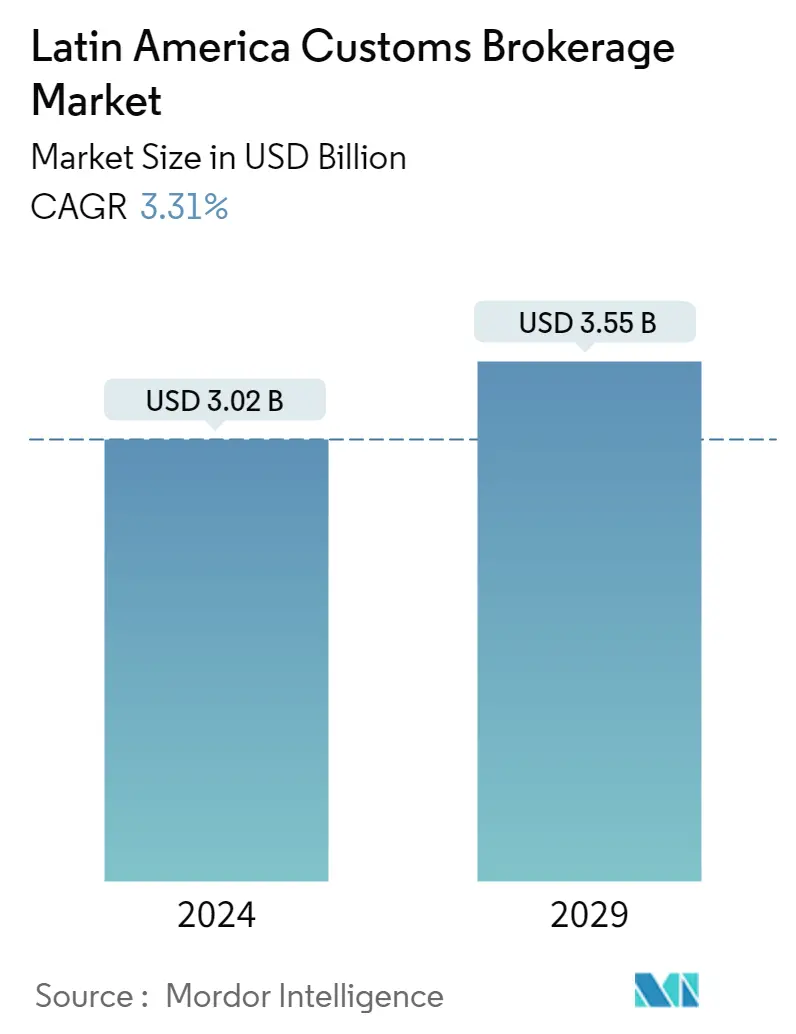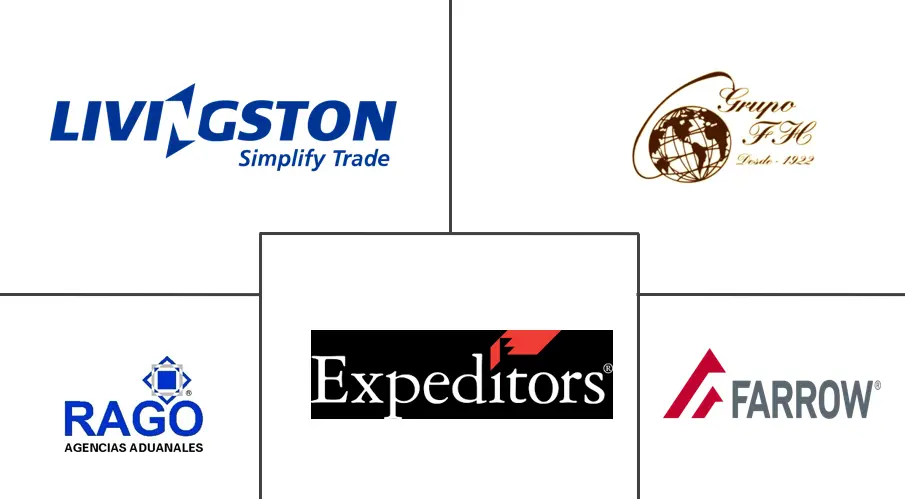
| Study Period | 2020 - 2029 |
| Base Year For Estimation | 2023 |
| Forecast Data Period | 2024 - 2029 |
| Market Size (2024) | USD 3.02 Billion |
| Market Size (2029) | USD 3.55 Billion |
| CAGR (2024 - 2029) | 3.31 % |
| Market Concentration | Medium |
Major Players
*Disclaimer: Major Players sorted in no particular order |
Latin American Customs Brokerage Service Market Analysis
The Latin America Customs Brokerage Market size is estimated at USD 3.02 billion in 2024, and is expected to reach USD 3.55 billion by 2029, growing at a CAGR of 3.31% during the forecast period (2024-2029).
Combating the pandemic required countries to expedite the clearance and release of medicines, diagnostics, kits, and equipment. Customs organizations in countries including Peru, Panama, Colombia, and Chile quickly suspended their deadlines and procedures to prevent goods from falling into legal abandonment.
- For shippers entering the Latin American market, friction at the border can be striking. The bureaucracy and the outdated clearance practices often result in lengthy customs delays. This has led to rampant corruption, with many customs officials known to ask for bribes to expedite the clearance of goods.
- The companies operating in the logistics sector across various end users are proactively adopting the latest technologies and software platforms to carry out customs processes like documentation and customs clearance efficiently.
- The rapid growth in last-mile deliveries and the seamless, fast, and end-to-end deliveries in the logistics market are some of the main drivers for the sudden growth in the number of companies offering specialized customs brokerage services as a part of their portfolios.
- The growing adoption of IoT-enabled connected devices and the increasing adoption of tech-driven logistics services drive the growth of the Latin American customs brokerage market. In addition, the development of the e-commerce industry and the increase in reverse logistics operations boost the market growth. However, the lack of manufacturers' control of logistics services hinders the market's growth.
- The COVID-19 pandemic has affected many aspects of international trade in Latin America, including supply chain management, manufacturing, importing, exporting, customs, and logistics. Before the pandemic, the electronic transmission of data prior to the arrival of goods to customs was rare in the region outside of express mail.
Latin American Customs Brokerage Service Industry Segmentation
Customs brokerage is the regulatory clearance of shipments and the delivery of goods across international borders for organizations and individuals. These brokers have expertise in the entry procedures, admissibility requirements, classification, valuation, and the rates of duty and applicable taxes and fees for imported merchandise.
The Latin American customs brokerage market is segmented by mode of transport (ocean, air, and cross-border land transport), end user (automotive, chemicals, FMCG, retail, fashion and lifestyle, technology, reefer, technology, and other end users), and country (Mexico, Brazil, Chile, Colombia, Panama, and Rest of Latin America). The report offers market size and forecasts for the Latin America Customs Brokerage market in value (USD billion) for all the above segments.
| Ocean |
| Air |
| Cross-border Land Transport |
| Automotive |
| Chemicals |
| FMCG (Fast-moving Consumer Goods - Includes Beauty and Personal Care, Soft Drinks, Home Care, etc.) |
| Retail (Hypermarkets, Supermarkets, Convenience Stores, and E-commerce Channels) |
| Fashion and Lifestyle (Apparel and Footwear) |
| Reefer (Fruits, Vegetables, Pharmaceuticals, Meat, Fish, and Seafood) |
| Technology (Consumer Electronics, Home Appliances) |
| Other End Users |
| Mexico |
| Brazil |
| Chile |
| Colombia |
| Panama |
| Rest of Latin America |
Latin America Customs Brokerage Market Size Summary
The Latin America customs brokerage market is poised for growth, driven by the increasing complexity of international trade and the need for efficient logistics solutions. The market is characterized by a fragmented landscape with numerous domestic players, each navigating varying degrees of bureaucratic challenges and corruption at border points. The adoption of advanced technologies and software platforms is becoming essential for companies in the logistics sector to streamline customs processes, such as documentation and clearance. The rapid expansion of e-commerce and the rise of IoT-enabled devices are further propelling the demand for specialized customs brokerage services. Despite these advancements, challenges such as outdated clearance practices and the lack of control over logistics services by manufacturers continue to pose obstacles to market growth.
The COVID-19 pandemic has significantly impacted the customs brokerage landscape in Latin America, highlighting the need for expedited processes and electronic data transmission to enhance efficiency. Maritime logistics remain crucial, with ports playing a vital role in the distribution of goods, including essential supplies. The growth of international e-commerce is opening new markets for retailers, with Latin American consumers increasingly engaging in cross-border online shopping. This trend is supported by improved internet access through mobile devices, driving the expansion of e-commerce in the region. The market's growth is further supported by the burgeoning industries such as chemicals, pharmaceuticals, FMCG, and packaging, which are creating high demand for customs brokerage services. Major players like DHL and Rhenus Group are expanding their presence in the region, underscoring the market's potential and the ongoing efforts to enhance logistics and customs operations.
Latin America Customs Brokerage Market Size - Table of Contents
1. MARKET SEGMENTATION (Market Size by Value)
-
1.1 Mode of Transport
- 1.1.1 Ocean
- 1.1.2 Air
- 1.1.3 Cross-border Land Transport
-
1.2 End User
- 1.2.1 Automotive
- 1.2.2 Chemicals
- 1.2.3 FMCG (Fast-moving Consumer Goods - Includes Beauty and Personal Care, Soft Drinks, Home Care, etc.)
- 1.2.4 Retail (Hypermarkets, Supermarkets, Convenience Stores, and E-commerce Channels)
- 1.2.5 Fashion and Lifestyle (Apparel and Footwear)
- 1.2.6 Reefer (Fruits, Vegetables, Pharmaceuticals, Meat, Fish, and Seafood)
- 1.2.7 Technology (Consumer Electronics, Home Appliances)
- 1.2.8 Other End Users
-
1.3 Country
- 1.3.1 Mexico
- 1.3.2 Brazil
- 1.3.3 Chile
- 1.3.4 Colombia
- 1.3.5 Panama
- 1.3.6 Rest of Latin America
Latin American Customs Brokerage Service Market Research FAQs
How big is the Latin America Customs Brokerage Market?
The Latin America Customs Brokerage Market size is expected to reach USD 3.02 billion in 2024 and grow at a CAGR of 3.31% to reach USD 3.55 billion by 2029.
What is the current Latin America Customs Brokerage Market size?
In 2024, the Latin America Customs Brokerage Market size is expected to reach USD 3.02 billion.


